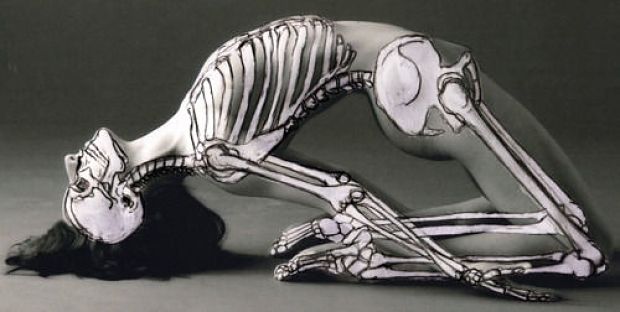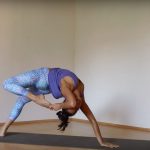6 Reasons To Stop Obsessing Over Alignment ~ Maya Devi Georg
 Settle down and unbunch your panties!
Settle down and unbunch your panties!
Yes, yoga poses must be taught and performed in a way that eliminates the risk for injury. And, yes, the poses should be visually recognizable. (If your Virabadrasana II looks more like a bucket of shit, chances are you’re doing it wrong!)
Asana (the physical exercises most folks simply call yoga these days) is not the goal of yoga, it is simply a tool. According to Patanjali, as described in the Yoga Sutras, the only alignment necessary is to be comfortable, steady, and relaxed in asana.
But many teachers today focus exclusively on the asanas and the physical body. As a long time yoga and asana teacher, I understand the necessity of studying anatomy and physiology. After all, asana is a physical practice. Understanding the human body—its capabilities and its limitations—can help teachers understand how to safely instruct students. It is useful in creating balanced sequences and modifying postures depending on a student’s abilities. It also makes you sound really smart!
But by placing all the focus on the body we ignore the many benefits to the mind and spirit. If asana is done correctly, the breath is paired with movement and attention is focused on a drshti (point of focus). Asana can be a form of meditation.
Yoga is like a gem, it is multi-faceted. These many facets reflect the light of a practice that extends far beyond mere asana, into breathing, meditation, and many more practices geared toward transforming the practitioner. Obsessing on alignment keeps all the emphasis on the asana and the body. It also emphasizes a level of detail that will neither prevent injury nor make the pose more visually appealing.
I have personally seen teachers spend 15 minutes of a class stressing the importance of perfect alignment in tadasana – the third toe of the foot absolutely had to be in a perfectly straight line from the ankle. This does not make a class safer, nor does it make a class more interesting. This was only a waste of 15 minutes of class time.
But beyond a way to waste class time, here are some more reasons I feel emphasizing alignment over any other principle of yoga, is misguided.
Whose Anatomy Are These Principles Based On?
All people have a unique anatomy. No two bodies are the same, we all have different strengths and weaknesses, and our joint structures can vary greatly. So why do we have styles of yoga that have a one-size-fits-all approach to alignment?
This is limiting to most students, and humiliating to others. Ignoring these skeletal and muscular differences only leads to injuries. This is simply irresponsible.
Almost all postures can be modified to accommodate every body type, and every physical limitation. Adhering to only one approved alignment principle excludes those that may not yet be flexible or strong enough, and those whose skeletal structure limits mobility.
It Emphasizes Perfection
Focusing exclusively on alignment sets students up for failure. If the standards set in a class are perfection, students are doomed. In some students this can create anxiety and insecurity. Neither is conducive to any part of a yoga practice.
I have seen in some styles of yoga, a pose must be performed ‘perfectly’ or not at all. Perhaps this makes sense if you are competing at the Olympics. But that’s gymnastics, not yoga.
Yoga is neither a performance, nor is it graded and judged. The best way to learn how to do yoga is by doing yoga, even if that means performing a simplified variation.
Doing the poses perfectly should not be seen as having perfect alignment. Perfection in asana occurs when the practitioner is performing the asana to the best of their ability, maintaining the steadiness and relaxation prescribed by Patanjali. This can be done by matching movement with breath, and maintaining the practice as a meditation.
It Creates Dependence to The Teacher
I once took an alignment-based class where the teacher informed me with every posture that I was “doing it wrong.” I was never told exactly what I was doing wrong, nor how to do those poses right. When I asked the teacher how to do the pose “the right way” he ignored me. I never went back.
I could see how some students would go back to that same teacher. After all, if they can see an error, they must be able to correct it. Surely, that teacher can show you the right way to practice. This behavior exploits student’s insecurities.
If your yoga teacher is telling you that you are doing every pose wrong, but does not tell you exactly what, or how to correct it, please, find a new teacher. Emotionally crippling students to keep paying off the teacher’s BMW lease is immoral.
A good teacher wants their students to exceed their own abilities, not keep students dependent. The only reason to go to a yoga class is to work on your practice. Your asana teacher is not enlightened. So focus on growing your practice, and growing as a person.
Do not focus on the teacher, they are the guide, not the goal.
It Limits Advancement
My own lineage does not focus on alignment beyond safety. And yet, I can do and have successfully and safely taught thousands of students how to do advanced asanas.
What is my secret? Just do the pose to the best of your ability. Sometimes that requires props, and other times spots. Yoga asanas can only be learned by doing them.
If you must wait to master one pose before you can begin working on another, you will wait, sometimes for years, while your body loses flexibility and strength. Besides, how long do you want to work on tadasana?
The best way to learn how to do an advanced (or any) asana is by doing those asanas. An experienced teacher is necessary to help break down the postures and build the necessary flexibility and strength for the pose. And, No!, just because a teacher can do the pose does not mean they can teach it, anymore than a teacher that can not do the pose means they cannot teach it.
It Makes Students Think & Not Feel The Pose
The most powerful part of an asana practice is not in the appearance of the pose, but in the flow of subtle energies within the body. When a teacher over-talks, giving far too many details about the alignment of a pose, it takes the student out of their body and into their mind. Instead of feeling they are thinking, and they are usually thinking “Am I doing this right?” (Cue the sneak peak to either a mirror or other students)
Asana can also be a meditation, and yogic meditation is nothing more that concentration. Giving students more cues, corrections, and directions only distracts students from focusing on being in the pose.
The purpose of yoga is to transform the self into the Self. In hatha yoga, we learn to control the body and breath as a precursor to controlling the mind. If the teacher is filling the minds of students with instruction after instruction, causing a student’s thoughts to spin wildly out of control, then the teacher has failed to teach yoga.
You Never Get Past Asana
Focusing only on the gross physical aspects of yoga is so limiting. Yoga is a vast field of study and there are many forms. Hatha Yoga, the yoga that includes asana, also emphasizes pranayama, meditation, and much more.
The lineages that rely most on alignment principles seem to include little, or no, pranayama or meditation in their classes (this is not a criticism, it is only an observation). This is mainly because pranayama and meditation cannot be explained through anatomy and physiology. Of course there are physiological responses to meditation, and respiratory physiology is fascinating.
But, the transformational power of pranayama and meditation are immeasurable and transcend the gross and physical world.
Yoga is more than getting fit. It is a spiritual practice. If we only focus on the body, we lose the true value of yoga as a whole. Let us use our bodies as a vehicle, not as an end. Worshipping our bodies will only disappoint us as we age, grow ill, and ultimately watch our bodies die.
Rather than aligning our bones and bodies, let us align our spirits and souls with our values, our morality, and our true Self.
Let us practice yoga, not just asana.



